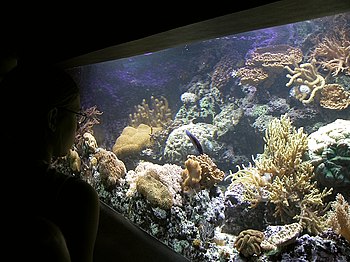 |
| Pink Convict Cichlid Male (Photo credit: Wikipedia) |
There are more than 2000 cichlid species around the world. Only a few species that are stunningly beautiful are sought after by aquarium owners. Some owners prefer the most common cichlids that are easy to feed, keep and breed.
Some of the popular and most common cichlids include
Some of the popular and most common cichlids include
Angelfish (Pterophyllum scalare) - Due to its mild disposition, inquisitive nature, elegant and unique appearance, the angelfish that is predominantly found in the Essequibo, Orinoco and Amazon rivers in South America are one of the most popular among aquarium owners. When it is feed time, these fishes swim eagerly to the surface or swim towards the glass as they are not shy with humans. Angelfish, the most common cichlids sought after by aquarium owners tolerate any water condition and are the easiest to feed.
Oscar fish (Astronotus ocellatus) - This fish, considered to be a food fish, originates from South America and is also referred to as Oscar, marble cichlid, velvet cichlid or tiger Oscar. Being extremely tough and hardy, Oscar fish can tolerate high toxin levels and any water condition. Oscar fish grows quickly even beyond eighteen inches and eats a variety of foods including flakes, live food and pellets. If you want your Oscar fish to stay bright, colourful and healthy, it is recommended to feed them with a lot of live food.
Convict cichlid (Archocentrus nigrofasciatus) - This fish is one of the most common cichlids sought after by beginners due to ease of breeding and due to their small size. They are not choosy about the water conditions or food. Convict fishes must be kept in appropriate surroundings. For this, you must recreate their habitat with a lot of artificial caves and rocks. These are used by them for breeding. It is recommended to use external filtration for this cichlid type as they burrow into the substrate.
 |
| Archocentrus nigrofasciatus caught in the warm outflow of a coal power plant in a temperate region of Victoria (Photo credit: Wikipedia) |
Discus fish (Symphysodon sppi) - Discus fish is another most common cichlid sought after by aquarium enthusiasts. This cichlid is very sociable and is one of the few varieties that live in large groups in their original habitat. It is recommended to purchase two or more discus fishes as they love to socialize and their character is enhanced through social interactions. Breeding tanks for discus fishes are very simple. They require many spawning sites, a simple filtration system and practically no substrate. In order to ensure that the eggs develop in a proper manner, keep the aquarium water soft.
Jack Dempsey - Interestingly, Jack Dempsey is named after a boxing heavyweight. This cichlid species are easy to feed and breed and live for a long period of time. Some Jack Dempsey fishes even live up to ten years. People love to keep Jack Dempsey's due to their vibrant colour. When they are young, these fishes feature a light grey or tan with specks of turquoise. As they grow mature, they turn purple-grey with green and blue highlights and golden specks.
By Frances Saville - Article Directory: EzineArticles |





